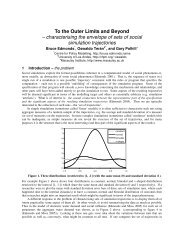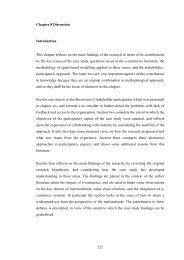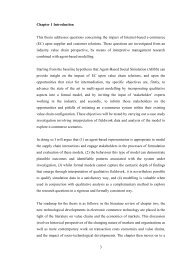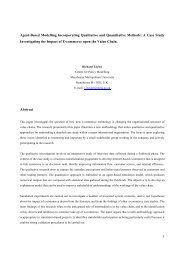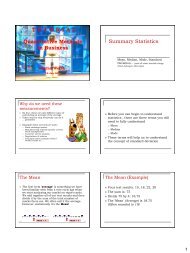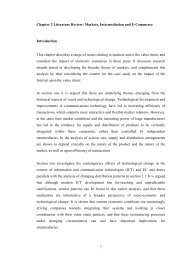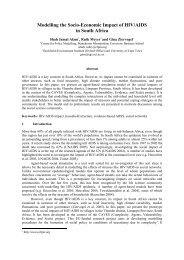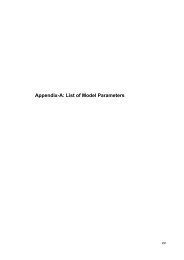Extended Abstract - Centre for Policy Modelling
Extended Abstract - Centre for Policy Modelling
Extended Abstract - Centre for Policy Modelling
You also want an ePaper? Increase the reach of your titles
YUMPU automatically turns print PDFs into web optimized ePapers that Google loves.
To meet these research objectives, agent-‐based modelling (ABM) is used – a powerful and innovative methodology, which is gaining more and more prominence in the scientific community – to identify and understand the effects of certain research policy strategies and their associated knowledge dynamics. In contrast to conventional methods of social research, this method is capable of dealing with the high complexity and non-‐linearity of the processes under study. ABM users can address questions that involve different levels of the innovation ecosystem: from start-‐up firms (micro level) to academic-‐industry partnerships (meso level) to whole sectors or regions (macro level). ABMs can be in<strong>for</strong>med by large empirical data sets. Our model (Simulating Knowledge Dynamics in Innovation Networks, SKIN) exactly contains these components: SKIN is a multi-‐agent model containing heterogeneous agents that act and interact in a complex and changing environment. The agents represent innovative actors who try to sell their innovations to other agents and end users but who also have to buy raw materials or more sophisticated inputs from other agents (or material suppliers) in order to produce their outputs. This basic model of a market is extended with a representation of the knowledge dynamics in and between the agents. Each agent tries to improve its innovation per<strong>for</strong>mance and its sales by improving its knowledge base through adaptation to user needs, incremental or radical learning, and co-‐operation and networking with other agents. SKIN is grounded in empirical research and theoretical frameworks from innovation economics and economic sociology. It is the result of a number of projects that combined empirical research into innovation networks with agent-‐based simulation. The model was used by the European Commission <strong>for</strong> scenario modelling of current and future innovation policy strategies referring to the technological sectors and EU Member States of the case studies. 3. The INFSO-‐SKIN application: ex-‐ante evaluation of Horizon 2020 To illustrate how the SKIN model works <strong>for</strong> research policy, the first application concerns the ex-‐ante impact assessment of ICT research in Horizon 2020, which was the subject of a tender study <strong>for</strong> the Evaluation Unit of DG INFSO (http://ec.europa.eu/dgs/in<strong>for</strong>mation_society/evaluation/index_en.htm). To address the evaluative questions of DG INFSO as stakeholder of the study, the FP7 model extrapolated into the future without any policy changes is taken as an evidence-based benchmark <strong>for</strong> further experiments. Against this baseline scenario the following example policy changes are tested to show the applicability of the model: (i) What if there would be changes to the instruments of funding? (ii) What if there would be changes to the overall amount of programme funding? The results of these simulation experiments reveal some likely scenarios as policy options <strong>for</strong> Horizon 2020. The study’s methodology of modelling the long-‐term impact of FP policies and assessing expectations <strong>for</strong> ICT research in Horizon 2020 had to be suitable <strong>for</strong> the following tasks: • Use the DG INFSO database on FP7 ICT networks as data input to calibrate the 4




